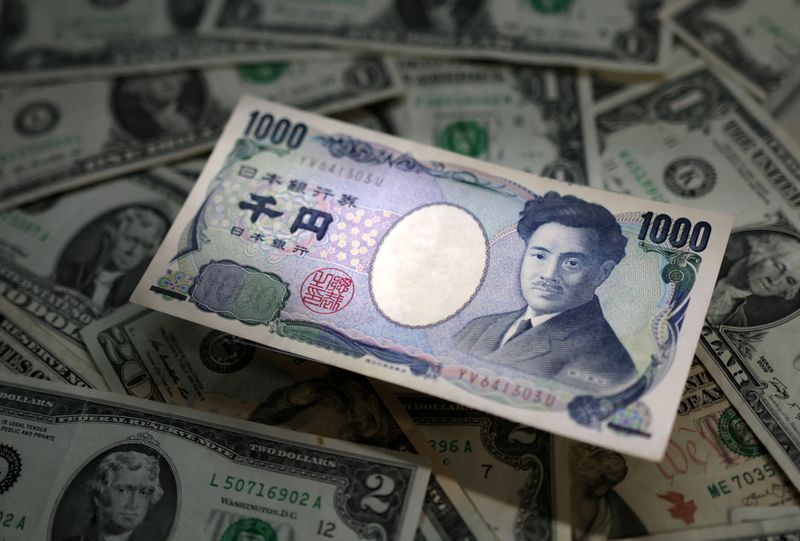 © Reuters. FILE PHOTO: Japanese Yen and U.S. dollar banknotes are seen in this illustration taken March 10, 2023. REUTERS/Dado Ruvic/Illustration/File Photo
© Reuters. FILE PHOTO: Japanese Yen and U.S. dollar banknotes are seen in this illustration taken March 10, 2023. REUTERS/Dado Ruvic/Illustration/File Photo
By Gertrude Chavez-Dreyfuss
NEW YORK (Reuters) - The yen plummeted across the board on Tuesday, dropping to a 15-year low against the euro and a new one-year trough versus the dollar, after a minor step adopted by the Bank of Japan (BOJ) toward ending years of monetary stimulus failed to appease some investors who had expected a bigger move.
At the conclusion of its two-day policy meeting, the BOJ further loosened its grip on long-term interest rates by tweaking its bond yield control policy again, taking another step toward reversing its controversial monetary stimulus of the past decade.
The BOJ said it would keep the 10-year government bond yield around 0% set under its yield curve control (YCC), but redefined 1.0% as a loose "upper bound" rather than a rigid cap.
It also removed a pledge to defend the level with offers to buy unlimited amounts of bonds.
The euro jumped against the Japanese currency to a 15-year high of 160.84 yen, and was last up 1.3% at 160.20 yen. It was on pace for its biggest daily gain since late July.
The yen slid to 151.715 against the dollar, a fresh one-year low as traders focused on the BOJ's dovish pledge to "patiently" maintain accommodative policy and forecast inflation would drop back below 2% in 2025. The dollar was last up 1.7% at 151.56 yen, on track for its best one-day increase since late April.
The Japanese yen had risen to a two-week high on Monday on a Nikkei report that the BOJ would tweak its yield curve control policy, prompting market participants to believe the BOJ would do more.
"The market was anticipating a more hawkish decision from the BOJ than what they got," said Erik Nelson, macro strategist at Wells Fargo Securities in London.
"The forward guidance was unchanged and the BOJ's inflation forecast still has core inflation below 2% at the end of its forecast horizon. So, yes, they did tweak policy, but it was not accompanied by a hawkish change in forward guidance on the policy rate."
BOJ Governor Kazuo Ueda, in a press briefing after the policy decision, signaled that the Japanese central bank was in no rush to end yield curve control or negative interest rates, even though Japan was making some progress toward sustainably achieving 2% inflation.
The Japanese unit also fell against sterling, the Swiss franc, and the Australian dollar.
The BOJ decision "does imply greater scope for Japanese yields to react to broader market forces going forward but markets are viewing this as too little, too late for the yen," wrote Shaun Osborne, chief market strategist at Scotiabank in Toronto.
He added, however, that an unwinding of positioning put in place ahead of the BOJ decision could be partly responsible for the yen's weakness as well.
HIGHER RATES FOR LONGER
In the United States, Tuesday's U.S. data continued to depict a resilient economy, in the latest indication that the Federal Reserve could keep interest rates elevated for some time.
U.S. labor costs increased solidly in the third quarter amid strong wage growth, data showed. The Employment Cost Index (ECI), the broadest measure of labor costs, rose 1.1% last quarter after increasing 1.0% in the April-June period.
Another piece of data showed that the U.S. annual home price growth accelerated for a third straight month in August. Home prices rose 5.6% on year over year basis, up from a 4.6% increase in the prior month.
Also on Tuesday, the Fed started a two-day policy meeting and is expected to leave interest rates unchanged but maintain its hawkish stance at the conclusion of the meeting. Analyts said the surge in U.S. Treasury yields and the stock market sell-off have already tightened financial conditions, giving the Fed the flexibility to stand pat.
The dollar index was last up 0.5% at 106.68. The index looked set to end the month broadly unchanged, but it remained supported by risks of another rate hike from the Fed, noting a solid and stable economy.
In other currencies, sterling was down 0.2% at $1.2146 ahead of a rate decision by the Bank of England later in the week where expectations are also for the central bank to hold rates unchanged.
========================================================
Currency bid prices at 3:01PM (1901 GMT)
Description RIC Last U.S. Close Pct Change YTD Pct High Bid Low Bid
Previous Change
Session
Dollar index 106.6300 106.1600 +0.46% 3.034% +106.8600 +105.8900
Euro/Dollar $1.0582 $1.0616 -0.32% -1.24% +$1.0675 +$1.0558
Dollar/Yen 151.5850 149.0500 +1.70% +15.62% +151.7050 +149.0300
Euro/Yen 160.42 158.20 +1.40% +14.34% +160.8400 +158.2100
Dollar/Swiss 0.9091 0.9019 +0.81% -1.67% +0.9104 +0.9010
Sterling/Dollar $1.2150 $1.2168 -0.14% +0.47% +$1.2200 +$1.2120
Dollar/Canadian 1.3864 1.3827 +0.28% +2.33% +1.3892 +1.3815
Aussie/Dollar $0.6342 $0.6374 -0.50% -6.97% +$0.6375 +$0.6315
Euro/Swiss 0.9620 0.9572 +0.50% -2.78% +0.9624 +0.9558
Euro/Sterling 0.8708 0.8720 -0.14% -1.54% +0.8753 +0.8701
NZ $0.5824 $0.5844 -0.34% -8.28% +$0.5857 +$0.5805
Dollar/Dollar
Dollar/Norway 11.1630 11.1420 +0.36% +13.94% +11.2040 +11.1320
Euro/Norway 11.8171 11.8160 +0.01% +12.56% +11.8840 +11.8058
Dollar/Sweden 11.1577 11.1378 -0.18% +7.21% +11.1930 +11.0858
Euro/Sweden 11.8037 11.8254 -0.18% +5.87% +11.8434 +11.8071

